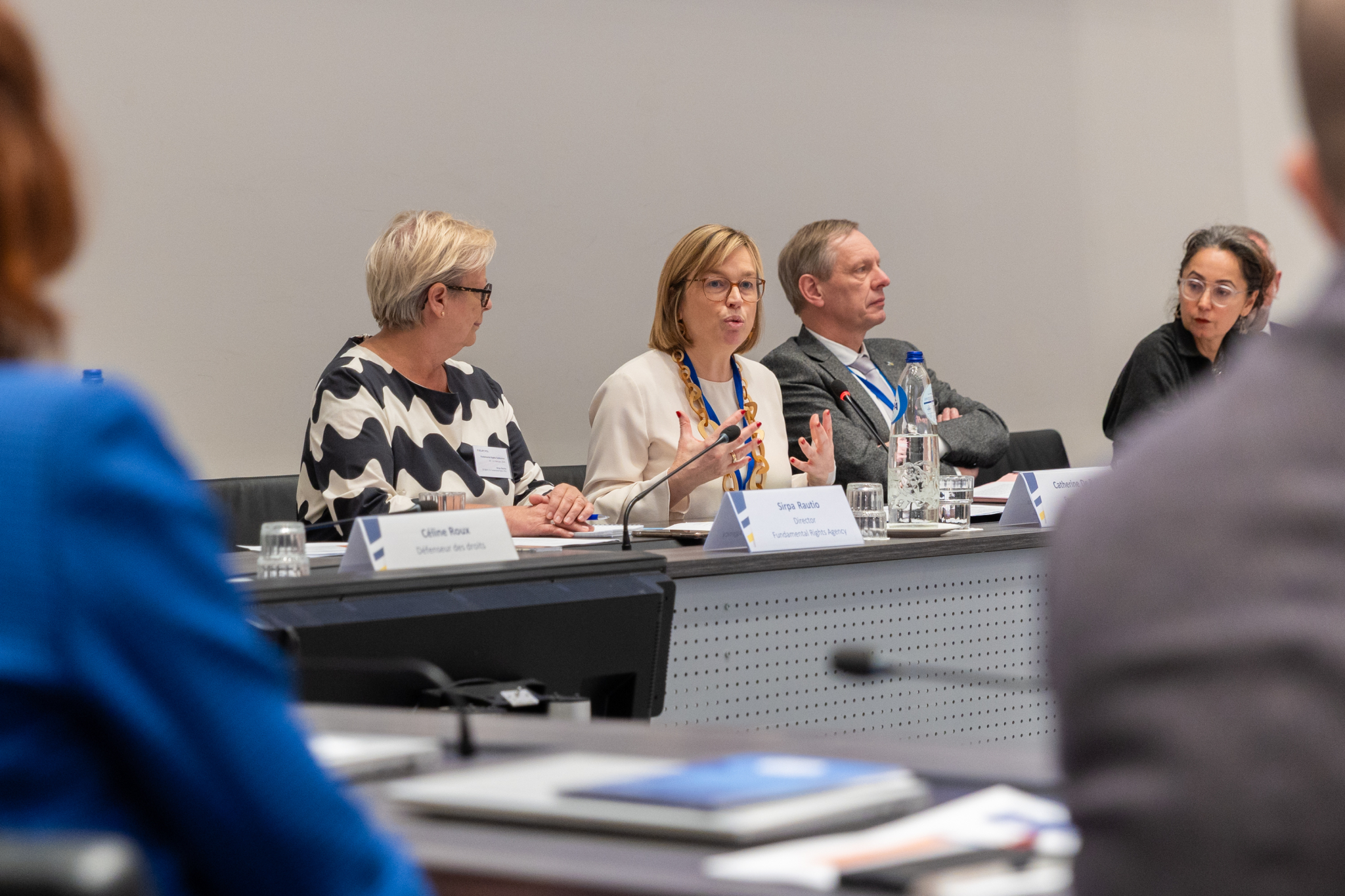Politics
First-of-its-kind conference on ‘Fundamental Rights at the Heart of Policing’

On 20 and 21 February 2025, experts from law enforcement authorities, academia and non-governmental organisations gathered at Europol headquarters for the first ‘Fundamental Rights at the Heart of Policing’ conference, organised by Europol’s Fundamental Rights Officer.
Over 130 participants from 25 EU Member States and 11 non-EU countries joined the event, as well as representatives from the EU Fundamental Rights Agency (FRA), the EU Border and Coast Guard (Frontex) and the EU Agency for Law Enforcement Training (CEPOL) who contributed to the exchange. Participants discussed and shared experiences and perspectives on respecting fundamental rights in policing, and finding collaborative ways to ensure these are embedded in law enforcement standards and practices.
Opening the conference, Europol’s Executive Director, Catherine De Bolle, said:
Fundamental rights are the bedrock of effective law enforcement. Trust is its cornerstone – yet it is fragile. Protecting fundamental rights, including data protection, is at the heart of Europol’s mission. Together with national authorities, we must ensure transparency, fairness and accountability – to safeguard the integrity of law enforcement in Europe, and to preserve the trust between police forces and the communities we serve.
During the two-day conference, experts discussed ongoing developments and current challenges in the area of fundamental rights. They focused on the causes and catalysts of possible fundamental rights violations, and how to fight racism and overcome cultural divides and social fragmentation through the effective promotion and upholding of fundamental rights in policing, as well as through continuous training, stakeholder engagement and improved processes.
The EU Fundamental Rights Agency’s Director Sirpa Rautio highlighted in her keynote speech:
Putting fundamental rights at the heart of policing will serve to achieve a just society for all. Delivering on the EU’s commitment to a safer and more secure Europe for all is only possible if fundamental rights remain at the centre of our actions.
Respect for fundamental rights is central to all law enforcement activities; it ensures compliance with the rule of law, gives accountability to public actors and provides a framework of ethical standards. Safeguarding privacy and data protection through proportionate, transparent and lawful practices is the duty of law enforcement, especially in the context of current rapid technological changes that require continuous evolution of methods, tools and policies.
Opening the second day, Frontex’s Director, Hans Leijtens, said:
The promise to serve and protect is only as strong as its foundation. Security and dignity are two sides of the same coin – without both, trust is lost. As leaders, we set the standard. Rules and regulations alone are not enough; culture begins at the top. Integrity in action is the key to earning and maintaining public trust. In law enforcement, tough decisions define us, and fundamental rights guide us. By upholding these principles, we don’t just safeguard borders – we uphold the dignity and rights of those who cross them.
The conference was concluded by Europol’s Fundamental Rights Officer, Dirk Allaerts, appointed in 2024 to support the Agency in safeguarding the respect of fundamental rights in all its mandated activities, with a focus on assessing the development and use of new technologies and their impact on fundamental rights.
Source link
Politics
President Costa to travel to Kananaskis, Canada for the G7 summit on 15-17 June 2025


© FRVS+MPCP 2022. The European Times® News is registered as an EU Trademark. All rights reserved. The European Times® and the logo of The European Times® are EU trademarks registered by FRVS+MPCP.
Members/Partners of

About Us
Popular Category
DISCLAIMER OPINIONS: The opinions of the authors or reproduced in the articles are the ones of those stating them and it is their own responsibility. Should you find any incorrections you can always contact the newsdesk to seek a correction or right of replay.
DISCLAIMER TRANSLATIONS: All articles in this site are published in English. The translated versions are done through an automated process known as neural translations. If in doubt, always refer to the original article. Thank you for understanding.
DISCLAIMER PHOTOS: We mostly used photos images that are readily available online, from free sources, or from the people promoting the news. If by any chance it happens that we have used one of your copyrighted photos, please do not hesitate to contact us and we will take it down without question. We do not make profits as this is a not for profit project to give voice to the voiceless while giving them a platform to be informed also of general news, and it is completely free.
Editor Picks
Politics
EU member states agree to extend temporary protection for refugees from Ukraine

Brussels, June 13, 2024 — In a rare display of unity amid Europe’s often-divided migration debates, EU member states today agreed to extend temporary protection for millions of Ukrainians displaced by Russia’s ongoing war of aggression. The decision, backed unanimously by the Council of the European Union, will prolong emergency protections until 4 March 2027 , offering stability and safety to over four million people who have fled Ukraine since February 2022.
The extension comes as Russian airstrikes continue to target civilian infrastructure across Ukraine, forcing more families to flee and preventing those already abroad from returning home safely.
“This is a clear signal that Europe remains united in its solidarity with Ukraine,” said Polish Interior Minister Tomasz Siemoniak, whose country holds the rotating presidency of the Council this semester. “While Russia continues to terrorize Ukrainian civilians, the EU continues to offer shelter, safety, and dignity.”
Since March 2022, the EU has provided protection under the Temporary Protection Directive (TPD) — an emergency mechanism activated for the first time in the bloc’s history. Designed to respond swiftly to mass displacement crises, the directive allows Ukrainian refugees to access housing, work permits, healthcare, education, and social assistance without undergoing lengthy asylum procedures.
Originally set to expire on 4 March 2026, the directive will now remain in force for another year. Crucially, the terms of protection — including eligibility criteria and the rights afforded to beneficiaries — remain unchanged.
Looking Ahead: Preparing for a Durable Solution
Beyond the immediate extension, EU countries are also beginning coordinated discussions on what comes next. Member states are examining a Council recommendation aimed at preparing for a phased transition out of temporary protection once conditions in Ukraine allow for safe returns.
“The war won’t last forever, and we must be ready for the day when peace returns,” Siemoniak added. “That includes thinking about how to manage a dignified return process and ensuring that those who wish to stay can regularize their status in line with EU law.”
The proposed strategy outlines plans for:
- Transitioning beneficiaries to longer-term residence permits or other legal statuses;
- Supporting voluntary returns to Ukraine;
- Providing accurate information to refugees about their options;
- Coordinating reintegration efforts within Ukraine and host communities across the EU.
The European Commission retains the authority to propose an earlier suspension of the directive should the security situation in Ukraine significantly improve.
What Is Temporary Protection?
Adopted in 2001 after conflicts in the Western Balkans, the EU’s Temporary Protection Directive serves as a rapid-response framework for large-scale displacement. It bypasses individual asylum procedures and grants collective protection to all eligible persons fleeing a specific crisis — in this case, Russia’s full-scale invasion of Ukraine.
Under the directive, beneficiaries enjoy essential rights across the EU:
- Legal residence;
- Access to employment and housing;
- Medical care;
- Social benefits;
- School enrollment for children.
However, implementation varies by country, with some member states offering additional support while others operate closer to the minimum standards.
A Necessary Measure, Not a Permanent Fix
While the extension brings relief to refugees and humanitarian organizations alike, it underscores the protracted nature of the conflict. Millions of Ukrainians — many of them women and children — remain unable to return home due to continued bombardments, lack of infrastructure, and active fighting in key regions.
“This is not a permanent solution,” stressed one EU official involved in the negotiations. “But in the current circumstances, it’s the only humane option.”
The formal adoption of the extension is expected at an upcoming Council session in the coming weeks.
As the war enters its third year, today’s decision reaffirms the EU’s commitment to stand by the Ukrainian people — not just in words, but in action. For now, temporary protection remains a vital lifeline, shielding millions from the worst consequences of a war they did not ask for.
The Council reaches a political agreement about extending the temporary protection for more than 4 million Ukrainians who fled from Russia’s war of aggression.
Source link
Politics
Schengen: Council approves declaration to commemorate 40th anniversary and renew its commitment for the common travel area

Brussels, June 13, 2025 — On the 40th anniversary of the signing of the Schengen Agreement, the Council of the European Union has formally adopted a new Schengen Declaration , reaffirming its unwavering commitment to preserving and strengthening Europe’s groundbreaking zone of free movement. The declaration underscores the importance of Schengen not only as an economic and social cornerstone but also as a symbol of European unity, resilience, and shared values.
The commemoration comes at a time when the Schengen area — now the world’s largest free movement zone — faces complex challenges ranging from migration pressures to evolving security threats. With over 450 million citizens benefiting from borderless travel, and more than two million people commuting daily across internal borders, the EU continues to rely on Schengen as a vital mechanism for fostering integration, trade, and cooperation.
A Pledge for Unity and Security
Polish Minister of the Interior and Administration, Tomasz Siemoniak , who currently holds the rotating presidency of the Council, emphasized the enduring significance of Schengen in today’s uncertain geopolitical climate:
“We have come together on the 40th anniversary of the signing of the Schengen Agreement to highlight our common commitment to Europe’s security, building resilience and readiness for today’s challenges,” said Siemoniak.
“Guided by our shared values, we pledge to continue investing in the common area without internal borders, ensuring strong management of our external borders, a more effective fight against illegal migration and a high level of internal security.”
Seven Pillars to Strengthen Schengen
In response to mounting pressures, the Council outlined seven key commitments aimed at reinforcing the integrity and effectiveness of the Schengen area:
- Upholding Core Values : Promoting respect for human dignity, freedom, democracy, equality, the rule of law, and human rights within a unified space of freedom, security, and justice.
- Preserving Free Movement : Ensuring that internal border controls remain a last resort while enhancing external border management, addressing secondary movements, and combating cross-border crime and terrorism.
- Enhancing Law Enforcement Cooperation : Deepening inter-agency collaboration and leveraging advanced IT systems to bolster security and facilitate seamless mobility.
- Humanely Managing Migration Flows : Preventing unauthorized entry and facilitating dignified returns for those without legal status.
- Strengthening External Relations : Improving visa policy, border control, and international cooperation with third countries on return and readmission processes.
- Building Mutual Trust : Encouraging joint responses to Schengen-related challenges among member states.
- Investing in the Future : Allocating sufficient resources and embracing innovation to ensure Schengen remains technologically and operationally robust.
A Legacy of Integration
Signed on June 14, 1985 , by five founding countries — Belgium, France, Germany, Luxembourg, and the Netherlands — the Schengen Agreement laid the foundation for what would become one of the most tangible achievements of European integration. Initially a bold experiment, it evolved into a transformative reality with the Schengen Convention of 1990 , which came into force in 1995, abolishing internal border checks between participating nations.
Today, the Schengen Area encompasses 29 countries , including all EU members except Cyprus and Ireland, as well as four non-EU countries: Iceland, Liechtenstein, Norway, and Switzerland.
Economic and Social Impact
Beyond its symbolic value, Schengen plays a critical role in Europe’s economy. Intra-EU trade reached a record €4.1 trillion in 2024 , facilitated by frictionless movement of goods and labor. Moreover, Schengen makes the EU the world’s top tourist destination , attracting nearly 40% of global international travelers annually.
As the EU looks ahead, the renewed Schengen Declaration serves as both a tribute to past achievements and a blueprint for future resilience. By combining historical legacy with modern adaptability, the bloc aims to safeguard one of its most cherished freedoms — the right to move freely across a continent once divided, now united.
The Council approves a declaration to mark the 40th anniversary of the signing of the Schengen Agreement.
Source link
-

 EU & the World5 days ago
EU & the World5 days agoWas Greta Thunberg Kidnapped by the IDF? Update on the Situation
-

 EU & the World6 days ago
EU & the World6 days agoDoes Carlos Alcaraz Have a Girlfriend? See the Tennis Player’s Relationship History
-

 Sports6 days ago
Sports6 days agoMarc Marquez triumphs at Aragon: “I feel fast, but I have to control myself”
-

 Sports6 days ago
Sports6 days agoBagnaia praises Ducati: “We have improved in so many ways”
-

 Sports7 days ago
Sports7 days agoRoma, Friedkins comment on Gian Piero Gasperini's arrival
-

 Sports5 days ago
Sports5 days agoNational team, Gianluigi Buffon makes mea culpa and sets new goal
-

 Politics7 days ago
Politics7 days agoEl Salvador: Statement by the Spokesperson on the Foreign Agents Law and recent developments
-
EU & the World6 days ago
L.A. Protests: Updates After Trump Deployed National Guard








